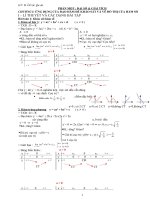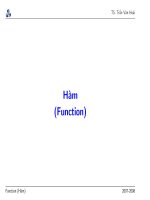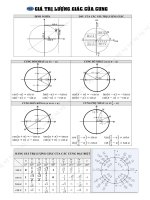slide toán rời rạc hay (bản đầy đủ ở file đính kèm)
Bạn đang xem bản rút gọn của tài liệu. Xem và tải ngay bản đầy đủ của tài liệu tại đây (226.55 KB, 20 trang )
Discrete Mathematics
Logic, Sets, Functions
Pham Quang Dung
Hanoi, 2012
Pham Quang Dung
Discrete Mathematics
Logic, Sets, FunctionsHanoi, 2012
1/1
Outline
Pham Quang Dung
Discrete Mathematics
Logic, Sets, FunctionsHanoi, 2012
2/1
Propositional Logic
Definition
A proposition is a statement that can be either true or false
Example
Hanoi is the capital of Vietnam (true)
1+2 = 5 (false)
Definition
Let p be a proposition. The statement “It is not the case that p” is called
the negation of p, denoted by ¬p
Pham Quang Dung
Discrete Mathematics
Logic, Sets, FunctionsHanoi, 2012
3/1
Propositional Logic
Definition
Let p and q be propositions. The proposition “p and q”, denoted by
p ∧ q, is the proposition that is true when both p and q are true and
is false otherwise.
p ∧ q is called conjunction of p and q
Definition
Let p and q be propositions. The proposition “p or q”, denoted by
p ∨ q, is the proposition that is false when both p and q are false and
is true otherwise.
p ∨ q is called disjunction of p and q
Pham Quang Dung
Discrete Mathematics
Logic, Sets, FunctionsHanoi, 2012
4/1
Propositional Logic
Definition
Let p and q be propositions
The exclusive or of p and q, denoted by p ⊕ q, is the proposition that
is true when exactly one of p and q is true and is false otherwise.
The implication p → q is the proposition that is false when p is true
and q is false and is true otherwise
The biconditional p ↔ q is the proposition that is true when p and q
have the sam truth value and is false otherwise
Pham Quang Dung
Discrete Mathematics
Logic, Sets, FunctionsHanoi, 2012
5/1
Propositional Equivalences
Definition
The propositions p and q are called logically equivalent (p ⇔ q) if p ↔ q
is always true
Example
¬(p ∧ q) ⇔ ¬p ∨ ¬q (see truth table)
p q ¬(p ∧ q) ¬p ∨ ¬q
T T
F
F
T F
T
T
F T
T
T
F F
T
T
p → q ⇔ ¬p ∨ q
Pham Quang Dung
Discrete Mathematics
Logic, Sets, FunctionsHanoi, 2012
6/1
Propositional Equivalences
p∧ T⇔ p
p∨ F⇔ p
p∨ T⇔ T
p∧ F⇔ F
p∧p ⇔p
p∨p ⇔p
¬(¬p) ⇔ p
p∨q ⇔q∨p
p∧q ⇔q∧p
p ∧ (q ∧ r ) ⇔ (p ∧ q) ∧ r
p ∨ (q ∨ r ) ⇔ (p ∨ q) ∨ r
p ∧ (q ∨ r ) ⇔ (p ∧ q) ∨ (p ∧ r )
p ∨ (q ∧ r ) ⇔ (p ∨ q) ∧ (p ∨ r )
Pham Quang Dung
Discrete Mathematics
Logic, Sets, FunctionsHanoi, 2012
7/1
Propositional Equivalences
¬(p1 ∧ p2 ∧ · · · ∧ pn ) ⇔ (¬p1 ∨ ¬p2 ∨ · · · ∨ ¬pn )
¬(p1 ∨ p2 ∨ · · · ∨ pn ) ⇔ (¬p1 ∧ ¬p2 ∧ · · · ∧ ¬pn )
p ∧ ¬p ⇔ F
p ∨ ¬p ⇔ T
Exercise
Show that (p ∧ q) → (p ∨ q) ⇔ T
Pham Quang Dung
Discrete Mathematics
Logic, Sets, FunctionsHanoi, 2012
8/1
Predicates and Quantifiers
The propositional logic is not powerful enough:
Example: the assertion “x is greater than 5”, where x is a variable, is
not a proposition because we cannot tell whether it is true or false
unless you know the value of x
Example
Q: Let P(x) denote the statement “x > 5”. What are the truth
values of P(1) and P(7)?
A: P(1) is false and P(7) is true
Definition
Propositional function: P(x1 , . . . , xn )
Pham Quang Dung
Discrete Mathematics
Logic, Sets, FunctionsHanoi, 2012
9/1
Quantifiers
When all the variables in a propositional function are assigned values,
the resulting statement has a truth value
Two types of quantification
Universal quantification ∀
Existential quantfication ∃
Definition
The universal quantification of P(x) is the proposition “P(x) is true
for all values of x” (denoted by ∀xP(x))
The existential quantification of P(x) is the proposition “There exists
a value of x such that P(x) is true” (denoted by ∃xP(x))
Pham Quang Dung
Discrete Mathematics
Logic, Sets, Functions
Hanoi, 2012
10 / 1
Predicates and Quantifiers
Example
Let Q(x, y ) denote “x + y = 0”. What are truth values of the
quantifications ∃y ∀xQ(x, y ) and ∀x∃yQ(x, y )?
Let Q(x, y , z) denote “x + y = z”. What are truth values of the
quantifications ∃z∀y ∀xQ(x, y , z) and ∀x∀y ∃zQ(x, y , z)?
Pham Quang Dung
Discrete Mathematics
Logic, Sets, Functions
Hanoi, 2012
11 / 1
Predicates and Quantifiers
NEGATION
¬∀xP(x) ⇔ ∃x¬P(x)
¬∃xP(x) ⇔ ∀x¬P(x)
Pham Quang Dung
Discrete Mathematics
Logic, Sets, Functions
Hanoi, 2012
12 / 1
Outline
Pham Quang Dung
Discrete Mathematics
Logic, Sets, Functions
Hanoi, 2012
13 / 1
Sets
Sets are used to group objects having similar properties
The objects in a set are also called the elements, or members of the
set
A set is said to contain its elements
Example
Set of even positive integers less than 8 can be expressed by {2, 4, 6}
Set of positive integers divisible by 5 less than 20 is {5, 10, 15}
Pham Quang Dung
Discrete Mathematics
Logic, Sets, Functions
Hanoi, 2012
14 / 1
Sets
Definition
Two sets are equal if and only if they have the same elements
The set A is called to be a subset of another set B if and only if every
element of A is also an element of B. We use the notation A ⊆ B to
indicate that A is a subset of the set B: ∀x(x ∈ A → x ∈ B)
Let S be a set. If there are exactly n distinct elements in S (n ≥ 0),
we say that S is a finite set and n is cardinality of S, denoted by
|S|: |S| = n
Pham Quang Dung
Discrete Mathematics
Logic, Sets, Functions
Hanoi, 2012
15 / 1
Cartesian product
Definition
The ordered n-tuple (a1 , a2 , . . . , an ) is the ordered collection that has
a1 is the first element, a2 is the second element, . . . , and an is its nth
element.
a1 , . . . , an ) and (b1 , . . . , bn ) are two ordered tuples.
(a1 , . . . , an ) = (b1 , . . . , bn ) iff ai = bi , ∀i = 1, . . . , n.
Let A and B be two sets. The Cartesian product of A and B,
denoted by A × B, is the set of all ordered pairs (a, b) where a ∈ A
and b ∈ B: A × B = {(a, b) | a ∈ A ∧ b ∈ B}
A1 × A2 × . . . An = {(a1 , a2 , . . . , an ) | ai ∈ Ai , ∀i = 1, 2, . . . , n}
Pham Quang Dung
Discrete Mathematics
Logic, Sets, Functions
Hanoi, 2012
16 / 1
Set operations
Definition
A ∪ B = {x | x ∈ A ∨ x ∈ B}
A ∩ B = {x | x ∈ A ∧ x ∈ B}
A − B (or A\B) = {x | x ∈ A ∧ x ∈
/ B}
A = {x | x ∈
/ A}
Properties
A ∪ (B ∪ C ) = (A ∪ B) ∪ C
A ∩ (B ∩ C ) = (A ∩ B) ∩ C
A ∪ (B ∩ C ) = (A ∪ B) ∩ (A ∪ C )
A ∩ (B ∪ C ) = (A ∩ B) ∪ (A ∩ C ))
A∩B =A∪B
A∪B =A∩B
Pham Quang Dung
Discrete Mathematics
Logic, Sets, Functions
Hanoi, 2012
17 / 1
Outline
Pham Quang Dung
Discrete Mathematics
Logic, Sets, Functions
Hanoi, 2012
18 / 1
Functions
Definition
Let A and B be two sets. A function f from A to B is an assignment
of exactly one element of B to each element of A.
We write f (a) = b if b is the unique element of B assigned by the
function f to the element a of A.
If f is a function from A to B, we write f : A → B
Functions can be specified in different ways:
Explicitly state the assignment
Use formula, for exapmle f (x) = x 2 + 2x
Write a computer program to specify a function
Pham Quang Dung
Discrete Mathematics
Logic, Sets, Functions
Hanoi, 2012
19 / 1
Functions
Definition
A function f is said to be one-to-one, or injective iff f (x) = f (y )
implies that x = y
A function f is said to be surjective iff for every element b ∈ B,
there is an element a ∈ A with f (a) = b
A function f is said to be bijective if it is both injective and surjective
Example
The function f (x) = x 2 from the set of integers to the set of integers
is neither injective nor surjective
The function f (x) = x − 4 from the set of integers to the set of
integers is both injective and surjective
Pham Quang Dung
Discrete Mathematics
Logic, Sets, Functions
Hanoi, 2012
20 / 1









